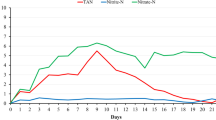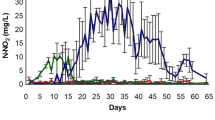Abstract
Finfish culture is a growing industry, and it causes a nutrient loading problem. To investigate the feasibility of an integrated culture of kelp and salmon, 15-cm long kelp (Laminaria saccharina) was grown in salmon culture effluent. The objectives were to test the effects of flow rate and kelp density on dissolved inorganic nitrogen removal (DIN), and DIN uptake and growth by the kelp. NH +4 , NO −3 and DIN (NH +4 + NO −3 ) loadings were in the ranges 6.2–25.4, 12.9–40.0, 19.7–52.7 μmol 1−1, respectively, over the experimental period.
Surplus uptake of nitrogen was not evident, because the C:N ratio (10–11) was constant in all experiments. During light periods, the kelp removed from 170–339 μmol 1−1 h−1, and approximately 26–40% of the incoming DIN. The DIN uptake rate, based on daylight sampling periods, ranged between 6.1–22.5 μmol g−1 dry mass h−1. The highest-flow rate, lowest-density tank had the highest DIN uptake rate. Debris from the fish effluent settling on the kelp thalli in the low-flow rate tanks affected uptake. Mean DIN uptake rate based on 3 days of growth for all flow-density combinations ranged between 5.4–8.3 μmol g−1 dry mass h−1. The kelp utilized NH +4 and NO −3 equally.
The growth ranged between 6.5–9% d−1. The biomass production ranged from 1–2 g per sampling period. The highest growth rate and biomass production were achieved by kelp in the highest-flow rate, lowest-density tank. Lower DIN concentrations due to higher DIN removal rates in the other tanks and light limitation due to self-shading in the high-density tanks were probably responsible for the reduced growth rate in these tanks.
Similar content being viewed by others
References
Ackefors H, Enell M (1990) Discharge of nutrients from Swedish fish farming to adjacent sea areas. Ambio 19: 28–35.
Amat MA, Braud JP (1990) Ammonium uptake byChondrus crispus Stackhouse (Gigartinales, Rhodophyta) in culture. Hydrobiologia 204/205: 467–471.
Atkinson MJ, Smith SV (1983) C:N:P ratios of benthic marine plants. Limnol. Oceanogr. 28: 568–574.
Bolton JJ, Lüning K (1982) Optimal growth and maximal survival temperatures of AtlanticLaminaria species (Phaeophyta) in culture. Mar. Biol. 66: 89–94.
Brinkhuis BH (1985) Growth patterns and rates. In: Littler MM, Littler DS (eds), Handbook of Phycological Methods — Ecological Field Methods: Macroalgae, Vol. IV. Cambridge University Press, Cambridge, 461–477.
Chapman ARO (1987) The wild harvest and culture ofLaminaria longicruris de la Pylaie en Eastern Canada. In: Doty MS, Caddy JF, Santelices B (eds), Case Studies of Seven Commercial Seaweed Resources. F.A.O, Rome, 193–238.
Chapman ARO (1973) Methods for macroscopic algae. In: Stein JR (ed.), Handbook of Phycological Methods: Culture Methods and growth Measurements. Cambridge University Press, Cambridge, 87–104.
Chapman ARO, Craigie JS (1977) Seasonal Growth inLaminaria longicruris: relations with dissolved inorganic nutrients and internal reserves of nitrogen. Mar. Biol. 40: 197–205.
Chapman ARO, Markham JW, Lüning K (1978) Effect of nitrogen concentration on the growth and physiology ofLaminaria saccharina (Phaeophyta) in culture. J. Phycol. 14: 195–198.
Cohen I, Neori A (1991)Ulva lactuca biofilters for marine fishpond effluent 1. Ammonia uptake kinetics and nitrogen content. Bot. Mar. 34: 475–482.
Conover JT (1968) The importance of natural diffusion gradients and transport substances related to benthic marine plant metabolism. Bot. Mar. 11: 1–9.
Csavas I (1990) New developments in Asian aquaculture. Aquaculture International Congress Proceedings. Aquaculture International Congress, Vancouver, British Columbia, 11–35 pp. 6.
Druehl LD, Baird R, Lindwall A, Lloyd KE, Pakula S (1988) Longline cultivation of some Laminariaceae in British Columbia, Canada. Aquaculture and Fisheries Management 19: 253–263.
Druehl LD (1988) Cultivation of edible kelp. In: Lembi CA, Waaland JR (eds), Algae and Human Affairs. Cambridge University Press, Cambridge, 119–134.
Enell M (1987) Environmental impact of cage fish farming with special reference to phosphorus and nitrogen loading. ICES. 13 pp.
Fivelstad S, Thomassen JM, Smith JS, Kjartansson H, Sando A (1990) Metabolite production rates from Atlantic salmon and Arctic char reared in single pass land-based brackish water and sea-water systems. Aquacult. Engng 9: 1–21.
Fujita RM, Lund D, Levin J (1989) Integrated salmon-seaweed mariculture (Research Notes). Northwest Env. J., Focus on Aquaculture 5: 164.
Gerard VA, DuBois K, Greene R (1987) Growth responses of twoLaminaria saccharina populations to environmental variation. Hydrobiologia 151/152: 229–232.
Gerard VA, Man KH (1979) Growth and production ofLaminaria longicuris (Phaeophyta) population exposed to different intensities of water movement. J Phycol. 15: 33–41.
Harlin MM, Craigie JS (1978) Nitrate uptake byLaminaria longicruris (Phaeophyceae). J. Phycol. 14: 464–467.
Harrison PJ, Druehl LD (1982) Nutrient uptake and growth in the Laminariales and other macrophytes: A consideration of methods. In: Srivastava LM (ed.), Synthetic and Degradative Processes in Marine Macrophytes. Walter de Gruyter and Co., Berlin, New York, 99–117.
Harrison PJ, Druehl LD, Lloyd KE, Thompson PA (1986) Nitrogen uptake kinetics in three year-classes ofLaminaria groenlandica (Laminariales:Phaeophyta). Mar. Biol. 93: 29–35.
Kraul S, Szyper J, Burke R (1985) Practical formulae for computing water exchange rates. Progr. Fish Cult. 47: 69–70.
Lapointe BE, Ryther JH (1979). The effects of nitrogen and seawater flow rate on the growth and biochemical composition ofGracilaria foliifera var.angustissima in mass outdoor cultures. Bot. Mar. 22: 529–537.
Lapointe BE, Tenore KR (1981) Experimental outdoor studies withUlva fasciata Delile. I. Interaction of light and nitrogen on nutrient uptake, growth and biochemical composition. J. exp. mar. Biol. Ecol. 53: 135–152.
Markovtsev VG, Krupnova TN (1988) Biological principles of the cultivation ofLaminaria algae for purification of fish processing plant effluent. Hydrobiological J. 24: 95–99.
Neori A, Cohen I, Gorden H (1991)Ulva lactuca biofilters for marine fishpond effluent 2. growth rate, yield and C:N ratio. Bot. Mar. 34: 483–489.
Penniman C (1988) Comparative growth and tissue chemistry responses of juvenileLaminaria longicruris sporophytes cultured in temperature and nitrogen concentrations gradients. J Phycol. 24 (Suppl.): 27.
Petrell RJ, Savage CT (1990) Modelling, monitoring and control of aquaculture operations. Paper presented at the International Conference: Engineering for Offshore Fish Farming. Institution of Civil Engineers. Albany Hotel, Glasgow.
Rosenberg G, Probyn TA, Man KA (1984) Nutrient uptake and growth kinetics in brown seaweeds: response to continuous and single additions of ammonium. J. exp. mar. Biol. Ecol. 80: 125–146.
Saito Y (1976) Seaweed aquaculture in the Northwest Pacific. In: Pillay TVR, Dill WM (eds), Advances in Aquaculture. Fish Farming News, Farham, 402–410.
Whitford LA, Schumacher GJ (1964) Effect of a current on respiration and mineral uptake inSpirogyra andOedogonium. Ecology 45: 168–170.
Whitford LA, Schumacher GJ (1961) Effect of current on uptake and respiration by a fresh-water alga. Limnol. Oceanogr. 6: 423–425.
Author information
Authors and Affiliations
Additional information
Author for correspondence
Rights and permissions
About this article
Cite this article
Subandar, A., Petrell, R.J. & Harrison, P.J. Laminaria culture for reduction of dissolved inorganic nitrogen in salmon farm effluent. J Appl Phycol 5, 455–463 (1993). https://doi.org/10.1007/BF02182738
Received:
Revised:
Accepted:
Issue Date:
DOI: https://doi.org/10.1007/BF02182738




